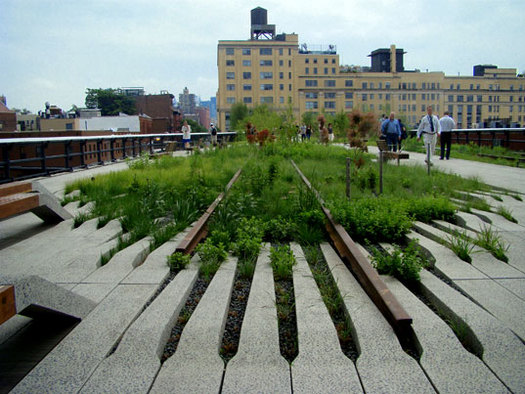
A couple of weeks ago I began work on a post about the High Line, but other matters intruded and I set it aside. The impetus then was a tendentious Times Op-Ed by Jeremiah Moss, the pseudonymous author of the blog Jeremiah's Vanishing New York. His argument: the High Line has turned Chelsea, previously a heterogenous blue-collar neighborhood, into a district overun by tourists and starchitect towers for the banker class, and that this represented "another chapter in the story of New York City's transformation into Disney World."
You'd have thought, from the tenor of the response, that he'd desecrated the grave of Jane Jacobs. On Twitter, the architectural cognoscenti shot him down right quick. Joshua David and Robert Hammond, the High Line's founding friends, answered in the Times. In the blogosphere, Matthew Gallaway authored the most convincing of many rejoinders. No, the High Line didn't catalyze Chelsea's transformation; it was inevitable. What businesses it displaced have been replaced by new ones that better serve the community. New York's economy depends on tourists. Change is both inevitable and necessary for a city to survive. People love the thing. Get over it.
I was somewhat surprised by the swiftness and bitterness of this response, given the cavils one does hear about this project behind closed doors. In his latest column for Metropolis, Philip Nobel (disclosure: a friend), spells out the contrarian argument, or at least some of it, in no uncertain terms:
I’ve never seen a bad review; was it reviewed as architecture at all? Certainly no one spanked the firm for its complicity in creating that aggressively not-quite-public space. Or commented on the obvious gimmickry of the design itself. The reintroduction of decorative railroad tracks (sometimes, bending to the design at the wrong gauge) was as much a sign of confusion as Peter Eisenman’s counterfeit armory facade at the Wexner Center. An intellectual hiccup. A gaffe. Ditto the look-at-me fussiness of the whole.I will say that I enjoy a stroll on the High Line — who doesn't? There really can be no question that it is a spectacular amenity for New York, and that its very existence as a (quasi) public space is basically miraculous. But I must also admit that I find it's very self-conscious design irritating (and already dating), and that its once raw industrial force has become unfortunately toy-like.
I also have some sympathy for Moss's arguments, even if he's wrong on the facts. It doesn't really matter if the High Line is the cause of Chelsea's transformation. It isn't, but it is a representation of that change, and perhaps the defining icon of the new Manhattan, for better and worse.
Robert Moses understood that parks are treated like motherhood — above and beyond criticism — and in his hands that knowledge became a blinding weapon. Nothing is above criticism. When something begins to develop that kind of reputation, think twice.
